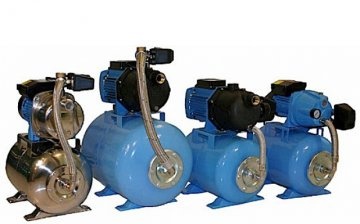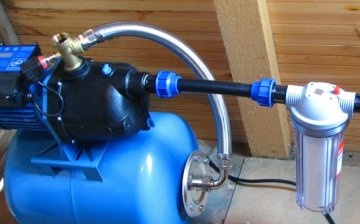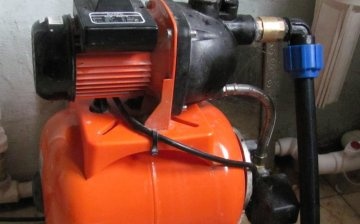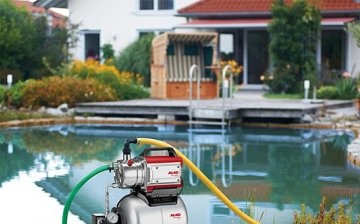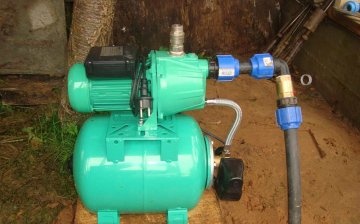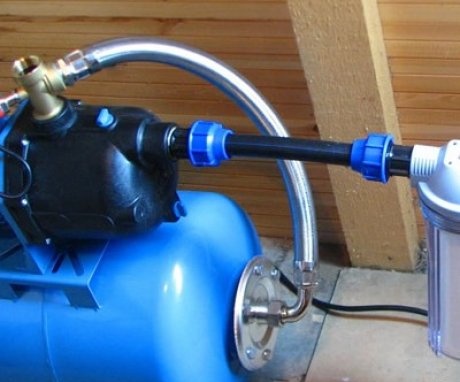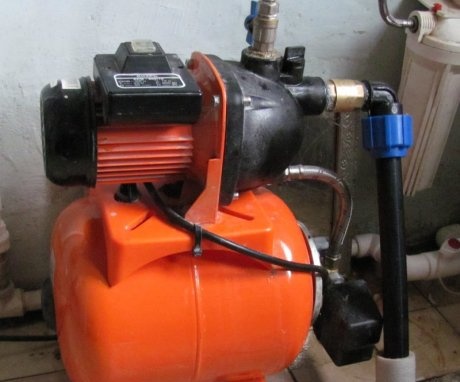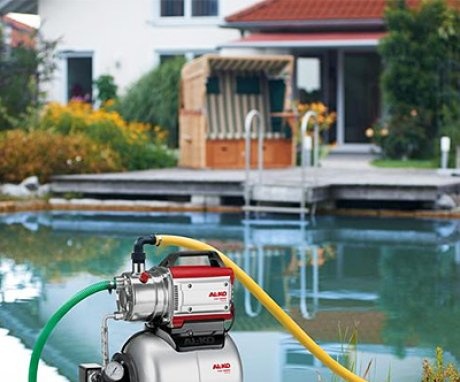How to choose a pumping station for a summer residence: types and do-it-yourself installation
For many cottage owners, it is not only a place to relax, but also a way of life. All year round, you can wait for the summer season to get started.
Content:
- Types of pumping stations
- What to look for when choosing a pumping station
- The principle of operation of the pumping station
- Do-it-yourself pump station installation
Types of pumping stations
A pump station is necessary to ensure a constant supply of water to the pipes. Water is supplied under a certain pressure, which makes it possible for all household appliances to work. If there is an autonomous water supply at the summer cottage, then connecting a pumping station to it will make it possible to have a full-fledged automated water supply system.
Such a plumbing system will work even in the absence of electricity. This option is possible if there is a supply of water in the accumulator.
There are several types of pumping stations:
- With an ejector. It has a built-in ejector. Its feature is the ability to raise water from a depth of no more than 45 meters. Such drifts have great productivity, but high power has a side effect - great noise. It is better not to place such a pumping station indoors, as this will interfere with comfortable living and recreation. It is recommended to build a separate room for a pumping station with a built-in floodlight. Therefore, this type is more expensive than others.
- The pumping station with a remote ejector is distinguished by its quiet operation, so it can be installed in a residential area. This type is more economical, it uses less energy for its work. A distinctive feature is the location of the ejector in the well itself. To install a station with a remote ejector, you need to study the property of the water supplied to the site. The ejector reacts negatively to the presence of mechanical pollution and even air bubbles in the water. This alluvial station is not so powerful; horizontally, it can supply water no more than 40 meters.
- Pumping stations without an ejector work on a different principle than the previous ones. They suck in water in stages. For this, hydraulic components are used. The pumping station without an ejector works quietly and is economical. Despite the other design, it can perform the same amount of work as pumps with ejectors.
- Another type of pumping station is increasing. In order for the water to flow in a continuous flow, vortex pumps will be connected to the water supply. This type of pump can work with any quality of water, this will not affect the performance and durability of the device in any way.
What to look for when choosing a pumping station
If the owner of the site did not have experience in construction work, then the question arises: how to choose a pumping station for a summer residence.
Tips for choosing a pumping station:
- First of all, a person must calculate how much water is consumed, how much is planned to be consumed. Depending on this indicator, the volume of the tank is selected. If water is needed not only for domestic needs, but also for working in the garden, then the tank will need as much as possible.
- Next, the performance of the pumping station is considered.The more water you need, the more power you need to choose.
- After that, you need to evaluate at what depth the waters pass. Based on this parameter, the type of pumping station and its capacity are also selected.
- The main parameters that pay attention to when buying a pumping station are performance and head. The pressure that the station produces, taking into account losses, also matters. Losses are the drop in pressure as water passes through the pipes.
- Next, attention should be paid to the material from which the pump body and tank are made. It can be made of steel or stainless steel.
- The stainless steel body is resistant to corrosion and can be installed outdoors. The cast-iron body works quieter, you can put it at home, but periodically check the integrity of the coating.
- Also, pumping stations may contain additional functions. For example, a water filter or a dry running sensor. The second device allows the station to automatically shut down if there is no water supply.
Buying and installing a pumping station is not a cheap pleasure, so it is better to immediately invest in a high-quality, powerful apparatus. It is necessary to decide which properties are really necessary for the suburban area, and which ones can be abandoned.
The choice of a pumping station also depends on the source of water available, whether it is a well or a well. If the distance to the source is too large, then you will have to additionally install a borehole pump.
The next criterion is a hydraulic accumulator. If there are a small number of people in the house, and there are only a few taps from which water will be supplied, then it is enough to purchase a 24-liter hydroaccumulator. If there are several points for parsing water, then it is better to immediately choose a 50 liter battery.
If at first it was not planned to use many parsing points, and then additional points appeared, then this does not matter. Another 24 liter battery can be installed.
The principle of operation of the pumping station
Depending on the preferences of the owner of the site, you can select a station according to one more criterion: by the type of control. They may be:
- Manual control
- Automatic
- Remote
Intuitively, you can guess how each of them works. In the first case, you will have to turn on and off the device yourself. The work of automatic stations is regulated with the help of special devices. The pumping station itself turns on when it is necessary and turns off in the absence of water or electricity.
Remote pumping stations are remotely controlled. This is done from the control room where the panel board is located. The entire installation consists of two types of pump, hose, diaphragm pressure tank, pressure gauge, adapter nipple and grounding terminal. A hydraulic accumulator and a storage tank are immediately purchased.
The work of the tank is as follows:
- First, water is pumped into the tank. When the tank is full, the machine stops working actively and goes into standby mode.
- Now the second part of the tank should reach a certain mark relative to the pressure. Now you can use water from the tap or to irrigate the area.
An automatic sensor monitors the water level. When there is less water, the station will repeat the cycle of actions, that is, it will refill the tank. There is a tank in the pumping station, it has already been mentioned, but its significance has not been emphasized. In one part of the tank there is water, in the second there is air, which is held under pressure. If the electricity suddenly turns off, the tank will serve as a hydraulic accumulator.
Water is pushed out of the tank by air pressure. The water can no longer get back, since a special valve is installed at the inlet. Water can only move into the house - into the water pipe.
If the pumping station has been working for a long time without interruption, for example, when watering a garden, then it may overheat.Modern stations are equipped with special sensors that stop the system in case of emergency. When, under the influence of cold water inside the tank, the device cools down, it will work again.
If a dacha or a country house receives visitors in the winter period, then the pumping station is installed only indoors. The ambient water temperature must be above 0, otherwise the water will freeze. This could damage the integrity of the pumping station. Pipes through which water enters the house should be laid at a level where the soil does not freeze. If water comes from a well, then it needs to be insulated.
Do-it-yourself pump station installation
Not only the quality of the water supply, but also the service life of the entire system depends on how correctly the equipment is installed and connected.
Connection is carried out according to a single scheme:
- The pumping station is installed strictly on a flat surface. It is better to fix the apparatus, because during intensive work it can vibrate and change its position.
- After that, the incoming line is constructed. The pipe is lowered into the water by 30 cm or less. The opposite side is connected to the pump. The angle towards the borehole must be observed.
- The inlet line and pump are filled with water through the outlet or filler port. After that, the pressure head is connected to the station. Now you need to manually adjust the desired pressure level in the tank.
- The main stages have been passed. Now the pumping station is plugged into the socket. You can see how the pump begins to pump water and fill the line and the battery. After filling with water of a certain volume, the pressure will reach 2.5-3 atm. and the device turns off.
Usually the well is located near the house. In order for water to flow smoothly from it to the right place, a pipeline is being laid. If water is needed in winter, and this is known in advance, the pipes are insulated. Installation work that must be carried out to install the pipes: digging a trench, preparing a hole in the foundation of the room for a future pipe, laying pipes, connecting the pipeline to the pumping station.
Perhaps the owners themselves do not suspect that groundwater passes close to the ground. But this problem can be solved. In this case, the pipes are installed above the water level, and heating cables or heat-insulating materials are used to protect against frost.
If the pipes are located above the freezing level of the earth, then basalt-based mineral wool is used.
This material is inexpensive and natural. There is nothing difficult in choosing and installing a pumping station. The main thing is to clearly understand the tasks that the system will perform.
More information can be found in the video.



